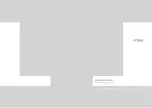
- 34 -
- 35 -
7. Lift and position the hood onto the brackets
at the bottom of the backside while keeping an
angle between the wall and the hood, and then
push the hood against the wall tightly.
Caution:
Two installers are required to ensure
safe installation.
8.Use three sets of screws (#10×2 13/16"(M5×70mm))
for upper cabinet boards and supporting
gaskets(φ1 5/16"(φ32mm))to fix the main body,
and secure at least two screws before releasing.
Range hood shel
the bottom
board of the
top cabinet
If there is a big gap between the bottom board
of the top cabinet and the top of the range hood,
please add wood pads based on the gap size near
the three #10×2 13/16"(M5×70mm) screws to
avoid range hood shell deformation caused by the
tightening of screws, which will affect the use of
the range hood.
Range hood shel
Wooden plate
the bottom
board of
thetop cabinet
9.Place the seal (notch downward) at the air outlet
of the machine and fix the outlet housing with 4
outlet-housing bolts of #8×3/4"(M4×18mm).Then,
secure the duct to the duct cover and seal the
connection with aluminum tape.
10. Install the smoke baffle plate.
①
Remove the "Installation Tips" on the smoke
baffle plate;
②
Take out one screw(#8×3/8"(M4×8mm)) in the
accessory bag (keep another screw for backup);
③
Open the Smoke Baffle Plate to the
maximum angle;
④
Fix the left bracket with the screwdriver and
screw;
⑤
Install Collision Avoidance Elements on both
left and right corners of the Smoke Baffle Plate.
11. Make sure the hood is leveled. Install the
Grease Cup, and plug in the appliance for a test
run.
Framing Stud
3. Locate the duct bracket. Determine the central
point and mark the centerline on the wall where the
hood will be installed. Also, mark the point where the
central line and the lowest point on the bottom board
of the top cabinet meet. This is the location, in which
to secure the bracket. Mark screw hole locations on
the wall. The distance between the lowest point on
bottom board of the top cabinet and the center of the
bracket should be 16" (405mm).
Hole A
Area C
Hole B
Hole A
Area C
Hole B
Caution:
One of the wood screws(#10×2
9/16"(ST5×65mm)) for main engine must be
fastened to the beam.Screws must be fixed
at Hole A and B in the drawing; also wood
screws(#10×2 9/16"(ST5×65mm)) must be fixed
at bracket bores with corresponding wooden
stakes in Area C.
4. Fixing hooks:
1) Punch marks are on tiles (marble): Punch holes
(φ3/8"(φ8mm)) with an electric drill at the marks,
and embed expansion tube for tiles(φ1/4"×1
5/16"(φ5.3×32mm)); fix hook with hook
screws(#8×1 7/16"(ST4.2×36mm)), and keep the
hook level with a level ruler.
2) Punch marks are on plasterboards: Screw
the expansion tube for plasterboards(φ3/16"×1
5/8"(φ4×40mm)) into walls with screwdrivers
at the marks; fix hooks with hook screws(#8×1
7/16"(ST4.2×36mm)), and keep the hook
horizontal with a level ruler.
5 .Place the hole-drilling template with the side
of the hole-drilling dimension drawing facing
down on the bottom of the upper cabinet, and
then drill the holes as indicated on the hole-
drilling template.
Caution:
Wear safety goggles when drilling.
In case of batten at the wall facing the bottom
plate, the rear wall side of the paper template shall
be cut as per the thickness of the batten.
If it is necessary to fix the hook on the tile, the “Rear
Wall” side of the hole-drilling template should be
attached to the bottom of the upper cabinet, using
the tile surface as a reference.
6. Remove the protective film of the stainless
steel surface and Grease Cup at both sides of
the range hood.
Summary of Contents for JQG7522
Page 13: ...JQG7522...
Page 15: ...2 3 125V 1 2 3 4 1 2 3 4 1 2 104 40...
Page 17: ...6 7 LED 1 2 132V 104V 3 4 5 6 A 1 2 3 4 5 6 2 3 LED 1 2 3 LED LED LED...
Page 22: ...16 17 8 9 10 8 3 8 M4 8mm 11 1 2 1 2 3 4 3 LED...
Page 23: ...43 JQG7522...
Page 36: ......
Page 37: ...110100052039D...










































